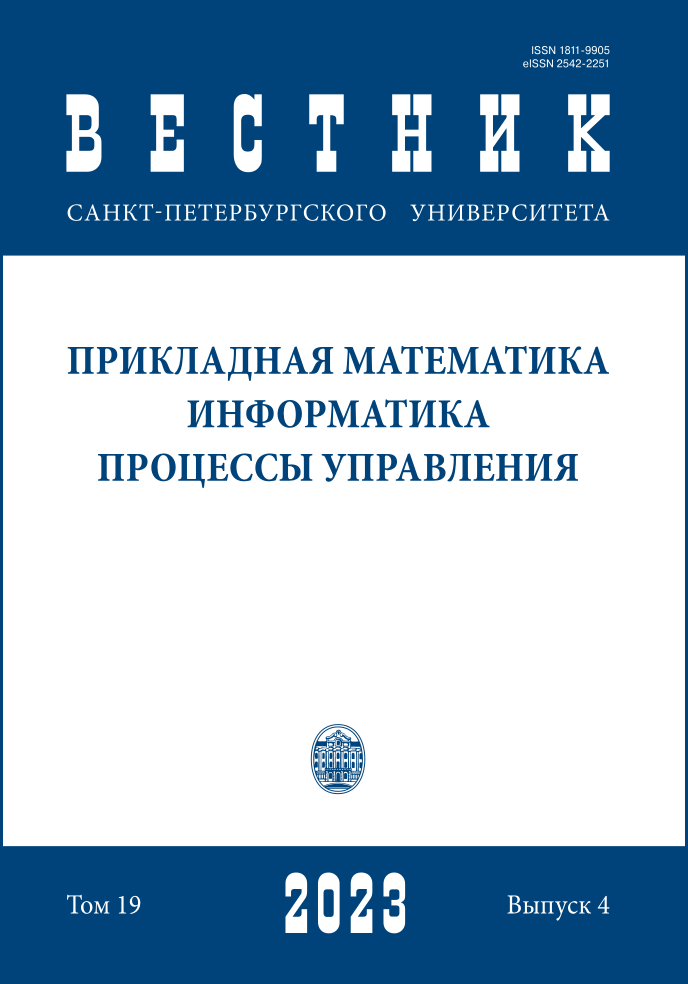Deep neural network based resource allocation in D2D wireless networks
DOI:
https://doi.org/10.21638/11701/spbu10.2023.409Abstract
The increased complexity of future 5G wireless communication networks presents a fundamental issue for optimal resource allocation. This continuous, constrained optimal control problem must be solved in real-time since the power allocation should be consistent with the instantly evolving channel state. This paper emphasizes the application of deep learning to develop solutions for radio resource allocation problems in multiple-input multiple-output systems. We introduce a supervised deep neural network model combined with particle swarm optimization to address the issue using heuristic-generated data. We train the model and evaluate its ability to anticipate resource allocation solutions accurately. The simulation result indicates that the trained DNN-based model can deliver the nearoptimal solution.
Keywords:
multiple-input multiple-output systems, deep neural networks, heuristics, particle swarm optimization
Downloads
References
References
Lu L., Li G. Y., Swindlehurst A. L., Ashikhmin A., Zhang R. An overview of massive MIMO: Benefits and challenges. Journal of Applied Statistics, 2014, vol. 8, no. 5, pp. 742–758.
Akbar N., Bjornson E., Larsson E. G., Yang N. Downlink power control in massive MIMO networks with distributed antenna arrays. IEEE International Conference on Communications (ICC), 2018, pp. 1–6.
Zhang X., Zhao H., Xiong J., Liu X., Zhou L., Wei J. Scalable power control/beamforming in heterogeneous wireless networks with graph neural networks. IEEE Global Communications Conference (GLOBECOM), 2021, pp. 1–6.
Ngo H. Q., Larsson E. G., Marzetta T. L. Energy and spectral efficiency of very large multiuser MIMO systems. IEEE Transactions on Communications, 2013, vol. 61, no. 4, pp. 1436–1449.
Shi Q., Razaviyayn M., Luo Z. Q., He C. An iteratively weighted MMSE approach to distributed sum-utility maximization for a MIMO interfering broadcast channel. IEEE Transactions on Signal Processing, 2011, vol. 59, no. 9, pp. 4331–4340.
Shen K., Yu W. Fractional programming for communication systems. Pt I. Power control and beamforming. IEEE Transactions on Signal Processing, 2011, vol. 66, no. 10, pp. 2616–2630.
Zhao Y., Niemegeers I. G., De Groot S. H. Power allocation in cell-free massive MIMO: A deep learning method. IEEE Access, 2020, vol. 8, pp. 87185–87200.
Reddy Y. B. Genetic algorithm approach for adaptive subcarrier, bit, and power allocation. IEEE International Conference on Networking, Sensing and Control, 2007, pp. 14–19.
Mukherjee A., Goswami P., Yan Z., Yang L., Rodrigues J. J. ADAI and adaptive PSO-based resource allocation for wireless sensor networks. IEEE Access, 2019, vol. 7, pp. 131163–131171.
Khanolkar S., Sharma N., Anpalagan A. Energy-efficient resource allocation in underlay D2D communication using ABC algorithm. Wireless Personal Communications, 2022, vol. 125, no. 2, pp. 1443–1468.
Bezmaslov M., Belyaev D., Vasilev V., Dolgintseva E., Yamshchikova L., Petrosian O. Optimizing DSO requests management flexibility for home appliances using CBCC–RDG3. Computation, 2022, vol. 10, no. 10, p. 188.
Sun H., Chen X., Shi Q., Hong M., Fu X., Sidiropoulos N. D. Learning to optimize: Training deep neural networks for interference management. IEEE Transactions on Signal Processing, 2018, vol. 66, no. 20, pp. 5438–5453.
Lee W., Kim M., Cho D. H. Deep power control: Transmit power control scheme based on convolutional neural network. IEEE Communications Letters, 2018, vol. 22, no. 6, pp. 1276–1279.
Eisen M., Zhang C., Chamon L. F., Lee D. D., Ribeiro A. Learning optimal resource allocations in wireless systems. IEEE Transactions on Signal Processing, 2019, vol. 67, no. 10, pp. 2775–2790.
Kennedy J., Eberhart R. Particle swarm optimization. Proceedings of ICNN'95 International Conference on neural networks, 1995, vol. 22, pp. 1942–1948.
Hamdi R., Driouch E., Ajib W. Resource allocation in downlink large-scale MIMO systems. IEEE Access, 2016, vol. 4, pp. 8303–8316.
Pellaco L., Bengtsson M., Jalden J. Deep unfolding of the weighted MMSE beamforming algorithm. arXiv preprint, 2020, arXiv:2006.08448.
Yang Z., Xia J. Y., Luo J., Zhang S., Gunduz D. A learning-aided flexible gradient descent approach to MISO beamforming. IEEE Wireless Communications Letters, 2022, vol. 11, no. 9, pp. 1895–1899.
Sun Q., Wu H., Petrosian O. Optimal power allocation based on metaheuristic algorithms in wireless network. Mathematics, 2022, vol. 10, no. 18, pp. 33–36.
Wang T. Y., Zhou H., Kannan R., Swami A., Prasanna V. Throughput optimization in heterogeneous MIMO networks: A GNN-based approach. Proceedings of the 1st International Workshop on Graph Neural Networking, 2022, pp. 42–47.
Alsharoa A., Ghazzai H., Alouini M. S. Energy efficient design for MIMO two-way AF multiple relay networks. IEEE Wireless Communications and Networking Conference (WCNC), 2014, pp. 1007–1011.
Koc A., Wang M., Le-Ngoc T. Deep learning based multi-user power allocation and hybrid precoding in massive MIMO systems. IEEE International Conference on Communications, 2022, pp. 5487–5492.
Kim D., Jung H., Lee I. H. Deep learning-based power control scheme with partial channel information in overlay device-to-device communication systems. IEEE Access, 2021, vol. 9, pp. 122125–122137.
Koc A., Le-Ngoc T. Swarm intelligence based power allocation in hybrid millimeter-wave massive MIMO systems. IEEE Wireless Communications and Networking Conference (WCNC), 2021, pp. 1–7.
Bezmaslov M., Belyaev D., Vasilev V., Dolgintseva E., Yamshchikova L., Petrosian O. Optimizing DSO requests management flexibility for home Appliances Using CBCC-RDG3. Computation, 2022, vol. 10, no. 10, pp. 188–201.
Markelova A. Y., Allahverdyan A. L., Martemyanov A. A., Sokolova I. S., Petrosian O. L., Svirkin M. V. Applied routing problem for a fleet of delivery drones using a modified parallel genetic algorithm. Vestnik of Saint Petersburg University. Applied Mathematics. Computer Science. Control Processes, 2022, vol. 18, iss. 1, pp. 135–148. https://doi.org/10.21638/11701/spbu10.2022.111
Markelova A., Petrosian O., Laistseva M. Microgrid management with energy storage system and renewable energy generation. Control Processes and Stability, 2021, vol. 6, pp. 430–434.
Downloads
Published
How to Cite
Issue
Section
License
Articles of "Vestnik of Saint Petersburg University. Applied Mathematics. Computer Science. Control Processes" are open access distributed under the terms of the License Agreement with Saint Petersburg State University, which permits to the authors unrestricted distribution and self-archiving free of charge.





